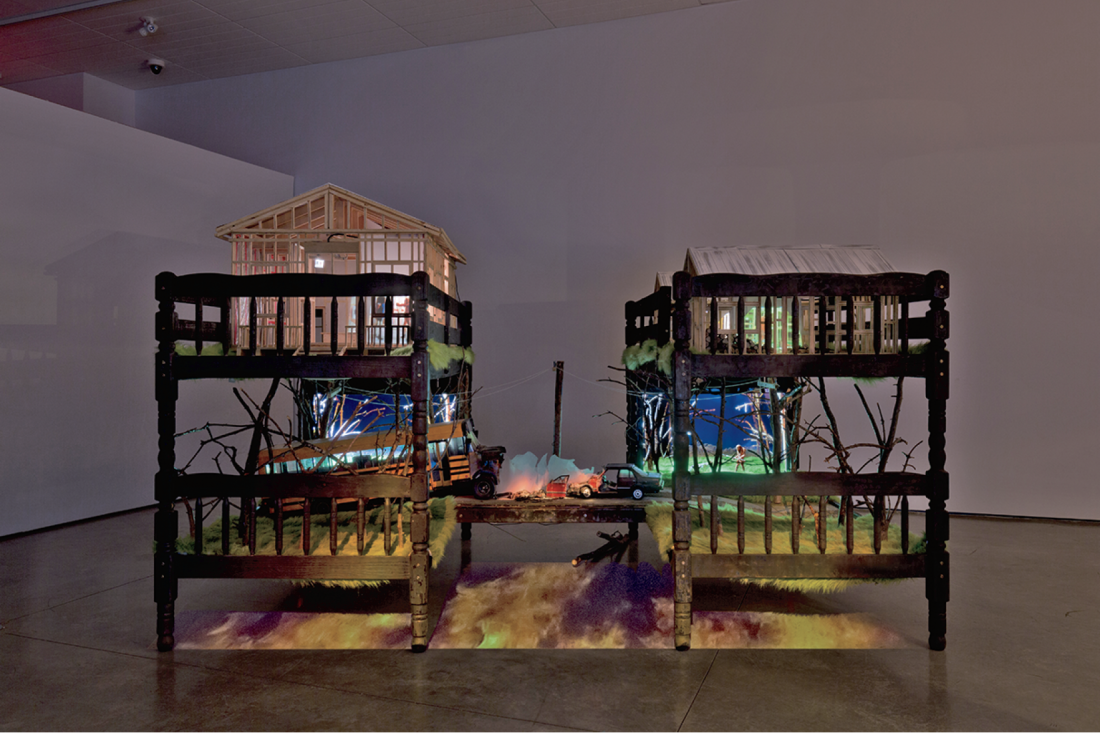Graeme Patterson
Graeme Patterson’s reputation is growing and he seems to be finally gaining national recognition. Twice the Atlantic region’s finalist for the Sobey Art Award and the 2012 recipient of the Canada Council’s Victor Martyn Lynch-Staunton Award for Media Arts, his recent project, “Secret Citadel,” was five years in the making and is a significant creative achievement. The project has been exhibited at a series of public art galleries across Canada, while the video portion of “Secret Citadel” has been screened at numerous film festivals and also toured the country as part of MASS MoCA’s “Oh, Canada” exhibition. Focussing upon the relationship between a bison and a cougar (representing Patterson and a friend with whom he grew up), the full project employs an innovative blend of animation, video projection and miniature dioramic sculpture as it examines the protagonists’ relationship through a series of masculine tropes and as they experience friendship, rivalry and estrangement. Most recently the work appeared at the Southern Alberta Art Gallery (SAAG) and the installation proved to be a fascinating and challenging viewing experience, demonstrating why Patterson is receiving so much recent attention.

Graeme Patterson, Camp Wakonda, 2013, mixed media installation. Photo by David Miller and Petra Malá Miller. Image courtesy Southern Alberta Art Gallery, Lethbridge.
The SAAG installation presented the project in two separate viewing spaces—one featured the video, the other contained the costumes worn during the video’s live-action sections and four “installations” based upon the miniature sculptural spaces that served as the sets for the video’s labourious stop-motion animations. This spatial division invited the audience to experience the work as an installation before experiencing it as an animated film, and offered the viewer more elaborate and complex versions of the project’s scenarios of friendship and maturation. The exhibition’s layout and implied sequence of experience also emphasized the project’s strong sense of melancholy. Diverging from the video’s chronological structure, the setting for the final section of the video, “The Player Piano Waltz,” is the first work in the installation room. The piece combines a miniature version of a dilapidated two-story tavern and hotel (with “gentlemen’s quarters” located on the upper floor) with a refurbished player piano that plays one of Patterson’s own compositions. Putting a coin into a slot starts a plaintive tune and animates the work, triggering the projection of several simultaneous scenes within the piece itself and into the surrounding exhibition space. Featuring the mature and now seemingly long-estranged bison and cougar, the installation’s depiction of the characters living out their waning years, each engaged in mundane, repetitive and solitary pursuits, divulges how the narrative concludes and begins the audience’s experience of the work with a feeling of eventual regret and resignation.
The inverted chronology initiated by “The Player Piano Waltz” also lends the project a strong sense of retrospection. Coloured by the inevitability of alienation, the subsequent installations each seem to transform remembered incidents of youth into ritualistic sagas of rivalry and conflict. Camp Wakonda’s temple-like structure (featuring bridged and charred bunk beds with the aftermath of an automotive accident) emphasizes the tension between camaraderie and conflict. Bathed in a projection of crackling flames, the former film set insinuates a sense of foreboding and inevitable doom, and as one witnesses the unfolding scenarios projected throughout the piece’s summer camp architecture, the implied immolation seems imminent as the bison and the cougar confront their animalistic identities, and each other. The sense of retrospection cast by “The Player Piano Waltz” also made “The Mountain” seem especially poignant. A utopian creative studio and teenage hangout in the film, in the installation, Patterson’s painstakingly reconstructed piles of the debris and detritus that littered the space cast the work as a paradise lost, and one only partially and ineffectively reconstructed.

Graeme Patterson, Camp Wakonda, 2013, mixed media installation. Photo by David Miller and Petra Malá Miller. Image courtesy Southern Alberta Art Gallery, Lethbridge.
The project’s sense of pervasive melancholy and hints of inadequacy can also be felt in the modest materiality of the installations themselves. In contrast to the array of technology used in the works’ many video and sound components, the installation objects seem largely constructed from humble and reclaimed materials. The tiny jerry-rigged settings are amazingly entrancing, but there is something Brechtian about the way the familiar is estranged and brought into a heightened state of importance through Patterson’s miniaturized remediation. Miniscule replicas and facsimiles of common items such as hot-glue guns, barbells and computers show Patterson’s ingenuity, but his attention to their nuanced detail also suggests his obsession and the extent to which the past haunts the present. His efforts to reconstruct and creatively elaborate upon his formative experiences are quite impressive but also somewhat unsettling. Revealing the modesty and impoverished materiality of the work, the “Secret Citadel” installation is ultimately a very bold creative gesture. As the curtain is pulled back we see not only the Oz-like machinery that produces the magic of the video but also the insignificant and disposable materials that the illusion is built upon—a stunning and disquieting glimpse of the substance of a creative obsession. ❚
“Secret Citadel” was on exhibition at the Southern Alberta Art Gallery from February 14 to April 12, 2015.
Richard Smolinski is a visual and performance artist working in Calgary. His current research concerns masculinity and measurement.

